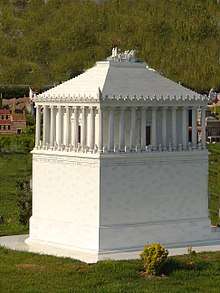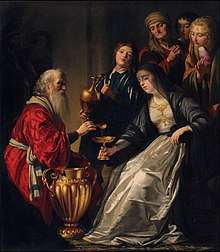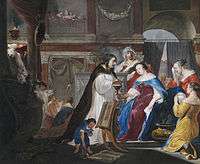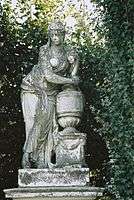Artemisia II of Caria
| Artemisia II | |
|---|---|
 Artemisia Prepares to Drink the Ashes of her Husband, Mausolus (c.1630) by Francesco Furini | |
| Satrap of Caria | |
| Reign | 353–351 BC |
| Predecessor | Mausolus |
| Successor | Idrieus |
| Consort | Mausolus |
| House | Hecatomnids |
| Father | Hecatomnus |
Artemisia II of Caria (Greek: Ἀρτεμισία; died 350 BC) was a naval strategist, commander and the sister (and later spouse) and the successor of Mausolus, ruler of Caria. Mausolus was a Persian satrap, yet enjoyed the status of king or dynast of the Hecatomnid dynasty. After the death of her brother/husband, Artemisia reigned for two years, from 353 to 351 BC. Her ascension to the throne prompted a revolt in some of the island and coastal cities under her command due to their objection to a female ruler.[1] Her administration was conducted on the same principles as that of her husband; in particular, she supported the oligarchical party on the island of Rhodes.[2]
Because of Artemisia's grief for her brother-husband, and the extravagant and bizarre forms it took, she became to later ages "a lasting example of chaste widowhood and of the purest and rarest kind of love", in the words of Giovanni Boccaccio.[3] In art, she was usually shown in the process of consuming his ashes, mixed in a drink.
Life
Artemisia is renowned in history for her extraordinary grief at the death of her husband (and brother) Mausolus. She is said to have mixed his ashes in her daily drink, and to have gradually pined away during the two years that she survived him. She induced the most eminent Greek rhetoricians to proclaim his praise in their oratory; and to perpetuate his memory she built at Halicarnassus the celebrated Mausoleum at Halicarnassus, listed by Antipater of Sidon as one of the Seven Wonders of the Ancient World and whose name subsequently became the generic term for any splendid sepulchral monument.[4]
Artemisia is known for commanding a fleet and played a role in the military-political affairs of the Aegean after the decline in the Athenian naval superiority.[5] The island republic of Rhodes objected to the fact that a woman was ruling Caria. Rhodes sent a fleet against Artemisia without knowing that her deceased husband had built a secret harbour. Artemisia hid ships rowers, and marines and allowed the Rhodians to enter the main harbour. Artemisia and her citizens met the Rhodians at the city walls and invited them into the city. When the Rhodians began exiting their ships, Artemisia sailed her fleet through an outlet in the sea and into the main harbour. She captured empty Rhodian ships, and the Rhodian men who disembarked were killed in the marketplace. Artemisia then put her men on the Rhodian ships and had them sail back to Rhodes. The men were welcomed in the Rhodian harbour and they took over Rhodes.[6]
Polyaenus, in the eighth book of his work Stratagems, mentions that when Artemisia (he may have been referring to Artemisia I, but more probably Artemisia II) wanted to conquer Latmus, she placed soldiers in ambush near the city and she, with women, eunuchs and musicians, celebrated a sacrifice at the grove of the Mother of the Gods, which was about seven stades distant from the city. When the inhabitants of Latmus came out to see the magnificent procession, the soldiers entered the city and took possession of it.[7]

Other monuments
Another celebrated monument was erected by Artemisia in Rhodes to commemorate her conquest of the island. The Rhodians, after regaining their liberty, made it inaccessible, whence it was called in later times the Abaton (άβατον).[8]
In later art
Artemisia drinking her husband's ashes was a subject in painting from the Renaissance onwards, especially enjoying a vogue in Dutch Golden Age painting around the middle of the 17th century, being painted by Rembrandt (Prado) among others. This was probably stimulated by the publication in 1614 of a Dutch translation of the collection of anecdotes of Valerius Maximus, who was active in the reign of Tiberius. Rembrandt for one can be shown to have read and used this book.[9]
Artemisia is always shown with a cup or urn, either alone or with a group of attendants offering or helping to mix the drink. The subject is therefore very similar to Sophonisba taking poison, and the Rembrandt, and a Donato Creti in the National Gallery, are examples of works where the intended subject remains uncertain between the two.[10]
Other cultural references
Artemisia received a full and friendly biography in the De mulieribus claris ("On Famous Women"), a collection of biographies of historical and mythological women by the Florentine author Giovanni Boccaccio, written by 1374. Boccaccio completely omits reference to her husband being her brother ("...knowledge of her parents or native country has not reached us..."), and praised her: "to posterity she is a lasting example of chaste widowhood and of the purest and rarest kind of love".[11]
 Master Of The Story Of Griselda, Siena, 15th century, one of a series of heroes and heroines who behaved well to the opposite sex
Master Of The Story Of Griselda, Siena, 15th century, one of a series of heroes and heroines who behaved well to the opposite sex Rembrandt, about 1634
Rembrandt, about 1634 Gerrit van Honthorst, about 1635, Princeton University Art Museum
Gerrit van Honthorst, about 1635, Princeton University Art Museum_-_Artemisia.jpg) Erasmus Quellinus II, 1652
Erasmus Quellinus II, 1652
 Arnold Houbraken, before 1719
Arnold Houbraken, before 1719 Johann Heinrich Tischbein, 1775, Portrait of Countess Augusta Reuss of Ebersdorf, Queen Victoria's grandmother, as Artemesia
Johann Heinrich Tischbein, 1775, Portrait of Countess Augusta Reuss of Ebersdorf, Queen Victoria's grandmother, as Artemesia Schönbrunn Palace, Vienna, 1773–80
Schönbrunn Palace, Vienna, 1773–80
Notes
- ↑ Pennington, Reina (2003). Amazons to Fighter Pilots: A Biographical Dictionary of Military Women. Westport, CT: Greenwood Press. p. 27. ISBN 0313327076.
- ↑ Diodorus Siculus, Bibliotheca, xvi. 36, 45; Demosthenes, Speeches, "On the liberty of the Rhodians", 11, 27
- ↑ De mulieribus claris ("On Famous Women"), Chapter 57, translation by Virginia Brown, Harvard University Press, 2003, ISBN 0674011309, 9780674011304
- ↑ Cicero, Tusculanae Disputationes, iii. 31; Strabo, Geography, xiv. 2; Aulus Gellius, Noctes Atticae, x. 18; Pliny, Natural History, xxv. 36, xxxvi. 4; Valerius Maximus, Facta et dicta memorabilia, iv. 6; Suda, s.v. "Artemisia", "Mausolos"
- ↑ Pennington, Reina (2003). Amazons to Fighter Pilots: A Biographical Dictionary of Military Women. Westport, CT: Greenwood Press. p. 27. ISBN 0313327076.
- ↑ Pennington, Reina (2003). Amazons to Fighter Pilots: A Biographical Dictionary of Military Women. Westport, CT: Greenwood Press. p. 28. ISBN 0313327076.
- ↑ Polyaenus: Stratagems- BOOK 8, 53.4 "Artemisia planted soldiers in ambush near Latmus; and herself, with a numerous train of women, eunuchs and musicians, celebrated a sacrifice at the grove of the Mother of the Gods, which was about seven stades distant from the city. When the inhabitants of Latmus came out to see the magnificent procession, the soldiers entered the city and took possession of it. Thus did Artemisia, by flutes and cymbals, possess herself of what she had in vain endeavoured to obtain by force of arms."
- ↑ Vitruvius, De architectura, ii. 8
- ↑ Golahny, Amy, Rembrandt's Reading: The Artist's Bookshelf of Ancient Poetry and History, pp. 129-133, 2003, Amsterdam University Press, ISBN 9053566090, 9789053566091
- ↑ Finaldi, Gabriele and Kitson, Michael, Discovering the Italian Baroque: the Denis Mahon Collection, p. 56, 1997, National Gallery Publications, London/Yale UP, ISBN 1857091779
- ↑ Chapter 57, translation by Virginia Brown, Harvard University Press, 2003, ISBN 0674011309, 9780674011304
References
- Smith, William (editor); Dictionary of Greek and Roman Biography and Mythology, "Artemisia (2)", Boston, (1867)
- Virginia Brown's translation of Giovanni Boccaccio’s Famous Women, pp. 115–118; Harvard University Press 2001; ISBN 0-674-01130-9

External links
| Wikimedia Commons has media related to Artemisia II. |
- Artemisia by Jona Lendering